SAFE Credit Union On How Member Involvement Impacts Product Innovations And Investments

Digital-first and customer-first credit unions are laser-focused on integrating member feedback into their innovation agendas. In the latest Credit Union Tracker, SAFE Credit Union’s Gina Olson explains how using data management solutions can help CUs capture and analyze member feedback to fine-tune their product roadmaps.
The past year’s events challenged credit unions (CUs), prompting many to refocus their innovation agendas on meeting their members’ changing needs.
CUs relied on their members to help guide them as vaccine distribution occurred across the U.S. and a new normal began to coalesce, and they retained certain existing programs while speeding efforts on others they had shelved. Sacramento, California-based SAFE Credit Union is one such entity that listened to its members to guide it in its planning.
CUs not only have to compete against larger banks and FinTechs, but they also have to deliver differentiation, which member input can fuel to a high degree. The CU’s senior vice president of Enterprise Applications, Gina Olson, explained in an interview with PYMNTS how SAFE involved its members in each aspect of the CU’s decision-making processes, including product investment and innovation.
“We’re very active in [our] community,” Olson said. “We have certain people whose full-time job is to [sample members’ needs].”
SAFE uses community events, focus groups, surveys and direct mail to gather feedback from its members. Consumer insights are also collected from social media channels and from one-on-one phone calls, online chat sessions and on-site encounters.
“We leverage members’ feedback quite a bit in informing our services and providing us information on things we want to roll out as a company,” she said. “That’s what credit unions are all about. We’re here for members.”
This high volume of structured data is processed through data management solutions to help SAFE better serve its member base and compete with other entities.
New Product Rollouts
SAFE put other projects on hold in March 2020 to roll out a digital, self-service, skip-a-payment loan program for members struggling to make loan payments and a self-service, partial payment option that allowed members to split payments into three-month installments. SAFE followed this with various self-service card control options that gave members the ability to switch debit and credit cards on and off, report stolen cards and have power over their transactions.
SAFE added several online service loan options as well and introduced an online appointment setting software via TimeTrade, through which users could schedule remote or in-branch appointments by phone or video. Olson said she saw that members gravitated to digital banking and contactless payments over the last five years and noticed that this trend accelerated over the past year as they sought more efficient ways to handle their banking activities. The CU prioritized the smooth transition from off-site interactions to online ones that offered more personalized banking experiences while remaining flexible to members who still desired on-site services.
“We tried to be flexible and serve members the way they wanted to be served,” she said. “Certain members wanted on-site assistance, others [wanted to interact] on [the] phone, onsite or remote. We looked at members … rather than at particular groups or demographics.”
The Digital Yet Personalized Balance
SAFE began to dust off innovation projects it had put aside as the pandemic began to ebb, although times had changed so much that many were no longer relevant, or members lacked interest in them. Projects that interested members and that SAFE pursued included a digital issuance program with push provisioning to be rolled out by 2022. The CU also unveiled online offerings for loan origination and a highly in-demand, real-time payments business-to-business (B2B) and peer-to-peer (P2P) payment feature.
One of its most ambitious and expensive efforts will be to replace its core banking platform by next year. SAFE plans to augment its mobile channel for members that use mobile banking with diverse account servicing, loan servicing and other functionalities, providing mobile users access to everything they may need through their phones. Demand for digitization may be at an all-time high, but members still want a personal touch.
“A certain segment of our members are very tech-savvy,” Olson said. “They want to be on their phones and take care of business quickly and efficiently themselves. Other segments like to talk to someone and get appropriate assistance or come in and look someone in the eye … [and] have an appropriate conversation. … That’s really affected us this past year because the needs on how to [serve] them [have] changed through so many crises.”
All signs point to a more digital self-service payments future. This means prioritizing members before market research on demographics and constantly observing the latest payment developments to remain competitive. SAFE and other wise CUs must thus ramp up their digital upgrades while augmenting physical channels to satisfy diverse member bases.

